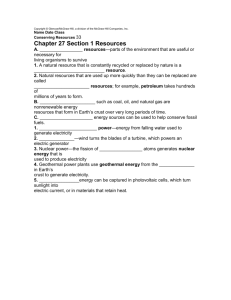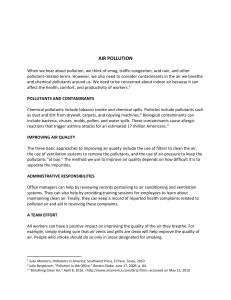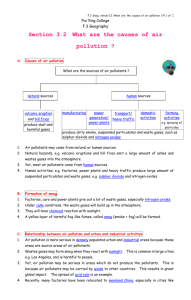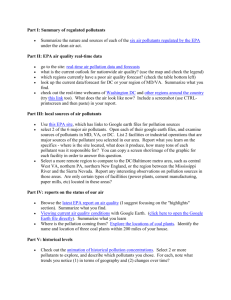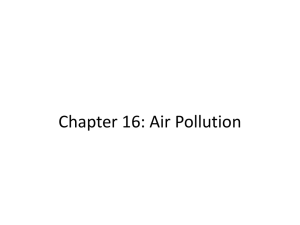Chapter 27 Conserving Resources
advertisement
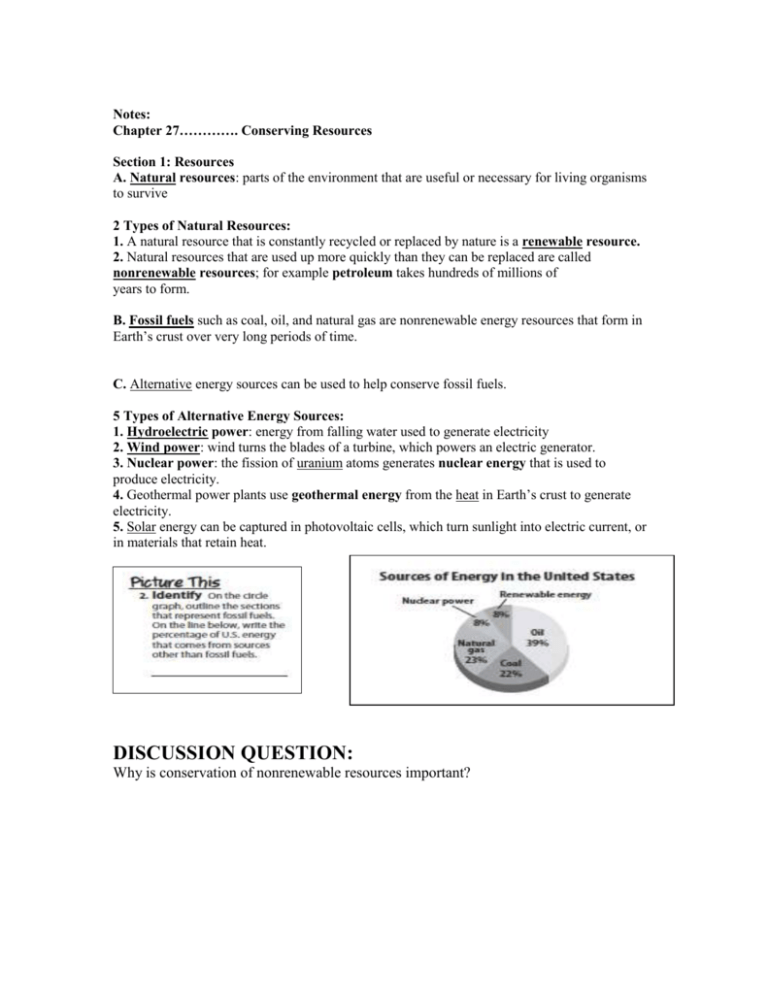
Notes: Chapter 27…………. Conserving Resources Section 1: Resources A. Natural resources: parts of the environment that are useful or necessary for living organisms to survive 2 Types of Natural Resources: 1. A natural resource that is constantly recycled or replaced by nature is a renewable resource. 2. Natural resources that are used up more quickly than they can be replaced are called nonrenewable resources; for example petroleum takes hundreds of millions of years to form. B. Fossil fuels such as coal, oil, and natural gas are nonrenewable energy resources that form in Earth’s crust over very long periods of time. C. Alternative energy sources can be used to help conserve fossil fuels. 5 Types of Alternative Energy Sources: 1. Hydroelectric power: energy from falling water used to generate electricity 2. Wind power: wind turns the blades of a turbine, which powers an electric generator. 3. Nuclear power: the fission of uranium atoms generates nuclear energy that is used to produce electricity. 4. Geothermal power plants use geothermal energy from the heat in Earth’s crust to generate electricity. 5. Solar energy can be captured in photovoltaic cells, which turn sunlight into electric current, or in materials that retain heat. DISCUSSION QUESTION: Why is conservation of nonrenewable resources important? Section 2: Pollution A. A pollutant is a substance that contaminates the air, land, or water. B. Air pollutants include soot, smoke, ash, and gases such as carbon dioxide, carbon monoxide, nitrogen oxides, and sulfur oxides. C. Smog is created when sunlight reacts with pollutants. D. Acid precipitation results from air pollutants reacting with water in the atmosphere. 1. Acid rain can kill plants and animals. 2. Reducing the use of high sulfur coal and lowering pollutants from vehicle exhaust can help prevent acid rain. E. The atmosphere traps heat through the greenhouse effect; increased carbon dioxide in the atmosphere may cause global warming. F. Ozone depletion, the thinning of the ozone layer, is caused by chlorofluorocarbons (CFCs) and can result in increased UV radiation reaching Earth’s surface. G. Insulation can trap indoor air pollutants such as carbon monoxide or radon. H. Water is polluted when air or land pollutants enter rivers, lakes, or oceans. 1. Surface water pollutants include chemical pesticides, raw sewage, and fertilizer. 2. Rivers and streams dump pollutants into the ocean; oil spills are also a source of seawater pollution. 3. Ground water can become polluted as it seeps through particles of rock and soil or collects in underground pools called aquifers. I. Erosion is the movement of soil from one place to another; it causes the loss of fertile topsoil. J. Soil can be polluted by solid wastes in landfills or by hazardous wastes such as dangerous chemicals or radioactive materials. Section 3: The Three Rs of Conservation A. Conservation can help prevent shortages of natural resources, slow growth of landfills, reduce pollution levels, and save money. B. Conservation includes reducing the use of natural resources. C. Conservation includes reusing natural resources. D. Recycling: reprocessing an item or natural resource for reuse 1. Different types of plastics can be sorted for recycling by recycle codes. 2. Steel and other metals are often recycled. 3. Glass bottles and jars can be reused or melted and reformed into new glass products. 4. Paper can be recycled to form new paper products 5. Vegetation waste can be composted and used as soil-enriching fertilizer. 6. Buying recycled products promotes conservation. DISCUSSION QUESTION: Why is it important to conserve natural resources?
